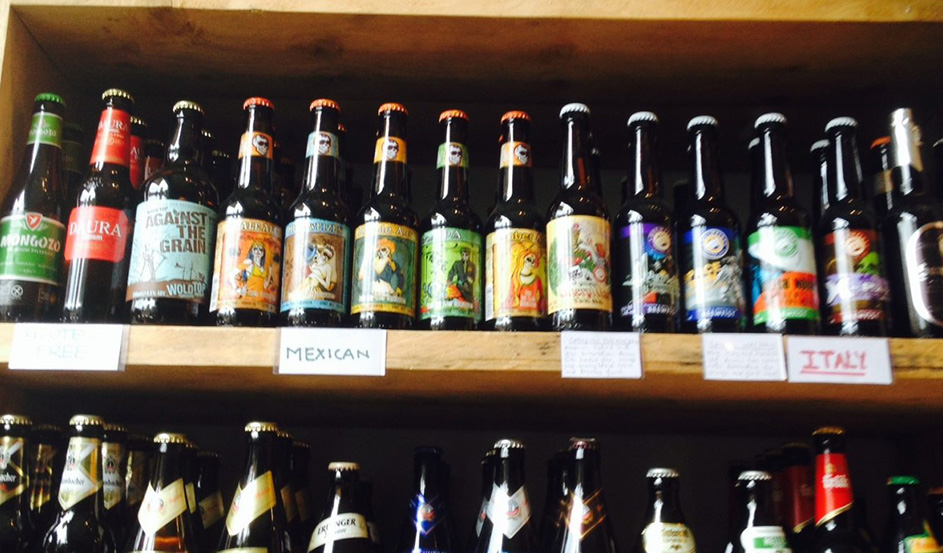
SAB MILLER EXPERIMENTAL DINNER
As part of our continued culinary odyssey the team at Kitchen Theory was delighted to work on a special private dining event for SAB Miller in conjunction with SAID Oxford Business School and hosted by Professor Charles Spence – head of Cross Modal studies at Oxford University.

Jozef Youssef introducing the multi sensory pairings
SABMiller is one of the world’s leading brewers with more than 200 beer brands and some 70,000 employees in over 75 countries. Twenty eight of its top executives are currently in London as part of an executive training program being delivered by SAID – Oxford University’s esteemed business school. As part of this course the organisers wanted to provide the SAB Miller executives with an insight into the world of ‘neurogastronomy’, so who better to involve in such a task than Professor Spence, with a little culinary support by the Kitchen Theory team!
Based on our continued interest in the field of neurogastronomy we were thrilled when Professor Spence sought our culinary assistance in organising an evening which included beer cocktails, a multisensory four course dinner with artisan beer pairing and insights into the world of neurogastronomy delivered by the professor.
Neurogastronomy is a field with an ever increasing level of interest by chefs the world round. Its focus is the manner in which our brain interprets flavour based on our five senses. Now although ‘taste’ may initially be considered the predominant sense when it comes to flavour perception it is really your sense of smell which is the star player. You can perceive around five main tastes (sweet, salty, sour and umami – although some claim up to sixteen different taste exist), you’re nose on the other hand can detect up to 80,000 different aroma compounds!
Simple experiment; pinch your nose and then pick a random jelly bean out of a packet, pop it in your mouth and try to guess the flavour. You will definitely get that it tastes sweet, maybe a little sour, but as for the actual flavour, it will only be once you let go of your nose and inhale that you are able to identify the flavour. We all experience this every now and again; when we catch a cold and our nose is blocked. People always talk about not being able to ‘taste’ food when they are sick, but it is mainly their blocked nose which is contributing to the distinct lack of ability to savour flavours.
Now other than taste it is clear that all our senses contribute towards our dining experience, whether it be the colour of our food, its smell, taste, texture, temperature, sound. All these elements make up our perception of a food. Take celery; if you don’t feel that crisp snap when you break off a stick from the bunch, you will instantly assume it’s not fresh. If a cucumber has no crunch, a chill is shrivelled and bruised, a steak is grey (from oxidization), a fish is smelly.. all these are not directly linked to ‘flavour’ however they will affect our perception of the food and in doing so will also affect our perceived flavour and subsequent enjoyment of a food.
Does a dish taste different on a white or black plate? Does an oyster taste different if you are listening to the sounds of the sea vs a barnyard soundscape? How does the glass you’re drinking from affect your experience of the drink? And if a foods colour is changed can you still tell what it is?

Selection of beers at DR.iNK of Fulham
All these questions and more were answered by Professor Spence with the aid of our culinary know how. And to do this we had to go away and do a lot of research in to beer! This was the main topic of the night and the brief was to develop a four course menu which highlighted the link between food, beer and the senses.
We started by selecting the key ingredient for each course and then building a flavour network around them. The next step was to understand more about brewing and beers, ales, stouts; ingredients, regional production methods, varieties, flavours and food pairings. Once we had passed these steps it was time to try some beer. So we began by heading down to DR.iNK of Fulham – a London ‘beer boutique’ opened in 2010, which has gathered many fans for its 600 different premium bottled beers.
Once we had narrowed down the selection, the next step was to test some key elements of the menu with the beers to see what would work best. The final step was of course finalising the menu and beer pairing.
So the final menu read as follows:
1st Course : Texture : Duck : Bavarian Smoked Beer
Sous vide duck, creamy smoked espresso polenta, cocoa reduction, stilton cream, smoked bacon crumble and crispy duck skin crisp

Sous vide duck, creamy smoked espresso polenta, cocoa reduction, stilton cream, smoked bacon crumble and crispy duck skin crisp paired with Bavarian smoked beer
2nd Course : Smell : Oxtail : Notting Hill Amber Stout
Ale braised oxtail tortellini, with oxtail consommé and shredded spring onion
3rd Course : Sight : Squid : Wheat beer
Squid ink risotto, squid, shrimp, dehydrated shrimp crumble and dill
4th Course : Taste : Stout : Chocolate stout
Stout mousse glazed with chocolate and gold dust, chocolate crumble, banana meringue, banana sponge, passion fruit caramel and stout pearls





Leave a Reply